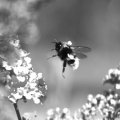University of Queensland scientists are making great advances in a collaborative project to develop a viable tropical abalone aquaculture industry for Australia.
A research team led by Dr Bernie Degnan is unlocking secrets of the tropical abalone (Haliotis asinina), a potential new domestic and export species for south-east Asian, North American and European markets.
The abalone industry contributes $120 million a year to the Australian economy, with aquaculture considered a reliable source of high-quality abalone.
Dr Degnan said despite huge expenditure into temperate species grown in South Australia and Tasmania, their slow growth rates, irregular spawning and long generation times had hampered industry advances.
'Smaller tropical species have recently emerged as viable alternatives to temperate species, because they are perfect for the cocktail abalone market recently developed by the North Americans and Japanese,' Dr Degnan said.
'There is an established market already for Haliotis asinina, with abalone fished in south-east Asia being consumed in that region, and in China, Japan, Europe and Australia.'
He said anecdotal information suggested the abalone would fetch A$50 a kilogram in the Asian market.
'As an example of the demand, the Philippines alone exported 500 tonnes of this species in 1993 - some of this shipment was imported by Australia,' Dr Degnan said.
'This level of demand clearly places pressure on natural stocks, but in spite of this, aquaculture production of this species is non-existent, and only in Queensland, Thailand and the Philippines are research efforts underway.'
Dr Degnan said Haliotis asinina had potential as a new aquaculture species for Australia, with the country having many logistical advantages over other countries, including suitable coastal sites.
The commercial attractiveness of the species lay chiefly in its rapid growth rate.
'This little guy is ready for market in less than a year, compared with five years for some temperate species,' Dr Degnan said.
'It has a well-documented spawning cycle that provides a regular source of abalone.'
The species occurs naturally in tropical Australian waters from the Great Barrier Reef to Ningaloo Reef, off Western Australia, as well as the Indo-Pacific and south-east Asia.
For the past three years, Dr Degnan's group has worked on the species in association with CSIRO.
They have been studying the biology of the species and identifying and manipulating genes that confer desired traits in culture.
Dr Degnan said the ongoing research had provided important insights into the reproductive and larval biology, nutrition, growth and genetics of the species.
The University of Queensland group has isolated a range of genes, including those encoding transcription factors and hormone processing enzymes that may be involved in regulating growth and/or reproduction.
Simultaneously, the researchers have developed mass gene transfer methods and expression vectors that contain gene promoters. They have also developed a battery of microsatellite DNA markers that will be applied to future selective breeding programs.
'We have undertaken market trials in Taiwan and Australia and have identified the international and national markets,' Dr Degnan said.
'We have also submitted the abalone for taste tests by two Asian restaurants in Sydney, indicating that the species is well suited to the Japanese style of cooking.
'The chef at the Japanese-style Tetsyua Restaurant, Sydney's restaurant of the year in 1996, indicated that the taste and texture were not significantly different from temperate species and could only be detected by a connoisseur.
'He also found that the edible yield from the tropical species was 90 percent, far outstripping the yield of 45 percent from temperate species. These features suggest that this abalone can fill a unique market niche that is not in competition with temperate abalone.'
Dr Degnan has been involved in abalone research in California and South Africa and was recently part of the South African industry reconstruction program at the University of Capetown. This project explored ranching communities in inter-tidal zones seeded with abalone to protect the species from poaching.
'Aquaculture provides full control and financial development for abalone farming,' he said.
Dr Degnan, a senior lecturer in the Zoology Department, has a joint appointment in the Centre for Molecular and Cellular Biology. He is involved in the tropical abalone collaboration with CSIRO Division of Marine Research and Western Australian Fisheries and Industry in Broome.
Dr Degnan's research group includes three PhD students, Australian Postgraduate Award holders Liz O'Brien and David McNamara and CSIRO Fisheries scholar Regina Counihan.
Media: For further information, contact Dr Degnan telephone 07 3365 2467, email: bdegnan@zoology.uq.edu.au



